“Good morning!” The owner of the dhaba in front of which we slept woke us up at 6am. First shop in the entire village of Neuli 1650m to open up. We ordered two chai’s and two omelette’s and were on our way. Aside from the road, there is a shortcut trail that climbs up straight to the Manu temple 2200m.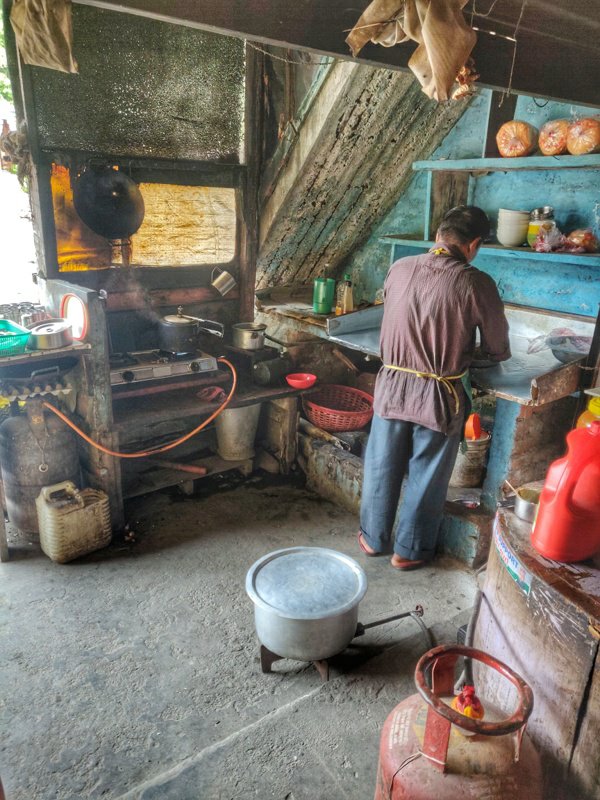 The path starts across the bridge from Neuli and hair pins up on the opposite ridge. Along the way we passed through scenic farming settlements on the steep valley slope. After a solid 550m ascent we reach the beautiful handcrafted wooden Manu temple. Kids from surrounding villages were passing by to attend nearby school.
The path starts across the bridge from Neuli and hair pins up on the opposite ridge. Along the way we passed through scenic farming settlements on the steep valley slope. After a solid 550m ascent we reach the beautiful handcrafted wooden Manu temple. Kids from surrounding villages were passing by to attend nearby school.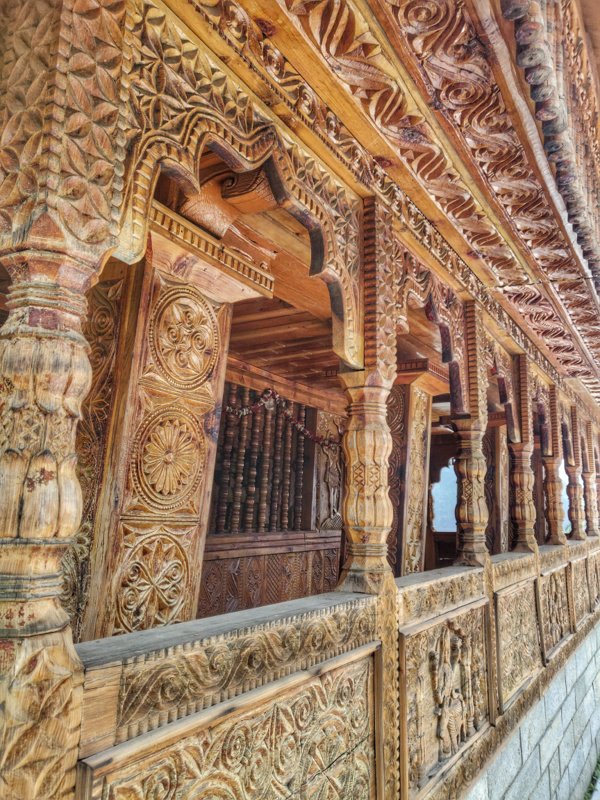 From the temple the path gradually contours up along a nice rocky path along the steep valley ridge offering scenic views on many hamlets in the valley below. The hamlets are hidden behind a ridge above the main Sainj valley below. Friendly people guide us along the way.
From the temple the path gradually contours up along a nice rocky path along the steep valley ridge offering scenic views on many hamlets in the valley below. The hamlets are hidden behind a ridge above the main Sainj valley below. Friendly people guide us along the way.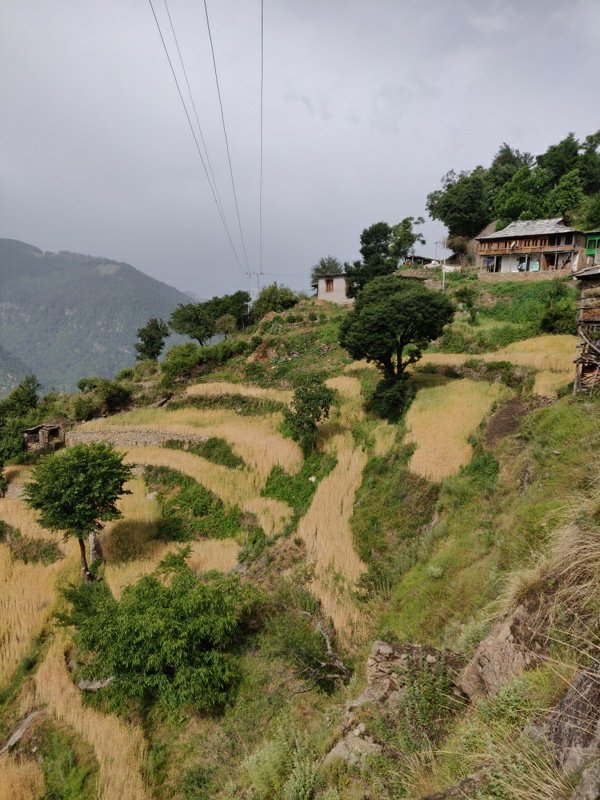 After another 300m gradual climb we reach the last village of Bagikashahri 2500m where we request the local shop owner to prepare 4 Maggie’s as the clock is touching mid day. Each house has its own handcrafted hand loom. Many small hamlets in Himachal still weave their own clothes and blankets.
After another 300m gradual climb we reach the last village of Bagikashahri 2500m where we request the local shop owner to prepare 4 Maggie’s as the clock is touching mid day. Each house has its own handcrafted hand loom. Many small hamlets in Himachal still weave their own clothes and blankets.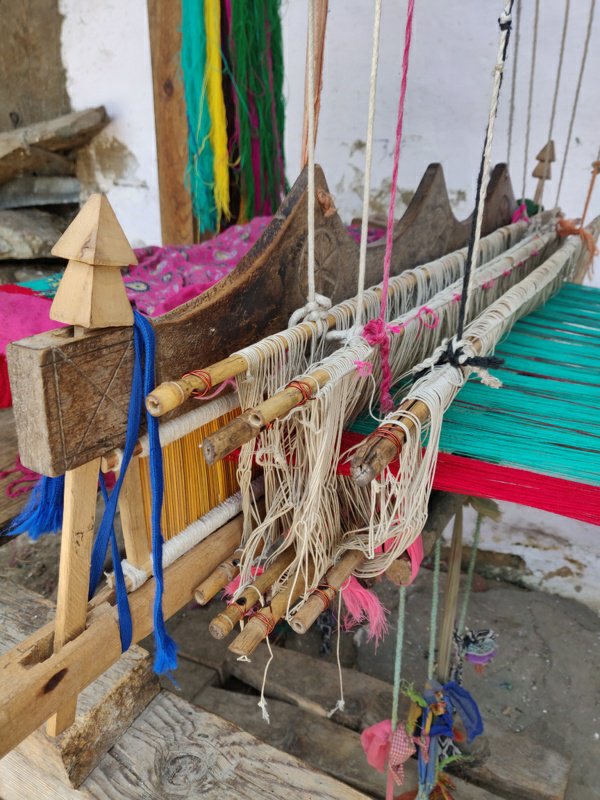 From Bagikashahri the path becomes a smaller trail that enters beautiful forest towards the Kandi Galu pass at 3627m. Initially we cross a few sidestreams. After that the trail climbs up steeply along a narrow ridge. A colourful spectacle of alpine flowers mark the trail.
From Bagikashahri the path becomes a smaller trail that enters beautiful forest towards the Kandi Galu pass at 3627m. Initially we cross a few sidestreams. After that the trail climbs up steeply along a narrow ridge. A colourful spectacle of alpine flowers mark the trail.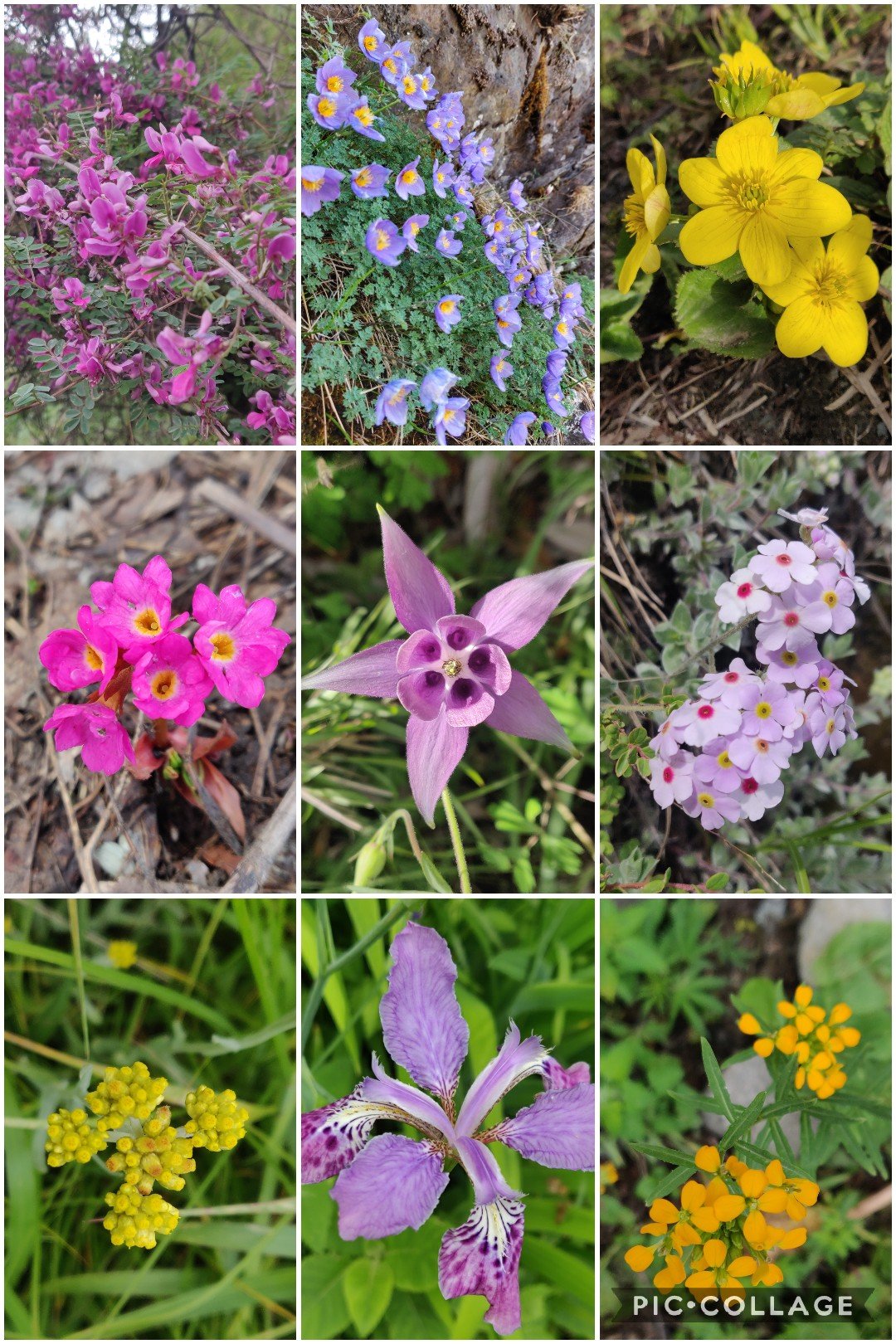 After a steady ascent we finally reach above the forest into the grasslands. From here the trail takes a left turn and climbs more gradually towards the pass along a steep rock face below the ridge which seperates the Sainj and Jiwa Nala valleys. On the other side of the pass beautiful rododendroms color the valley pink below the setting sun.
After a steady ascent we finally reach above the forest into the grasslands. From here the trail takes a left turn and climbs more gradually towards the pass along a steep rock face below the ridge which seperates the Sainj and Jiwa Nala valleys. On the other side of the pass beautiful rododendroms color the valley pink below the setting sun.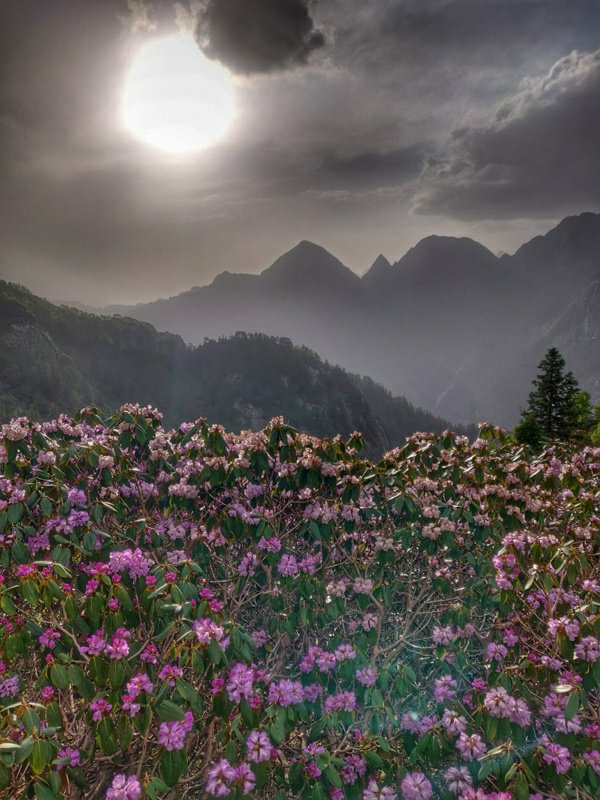 We crossed the pass pretty late by 6pm but the sun was still shining for another hour keeping us warm. The trail turn right and gradually descends into the Jiwa Nala valley. We need to drop around 300 meters to reach a suitable campsite. On the way we traverse across several remaining snow sections across side streams.
We crossed the pass pretty late by 6pm but the sun was still shining for another hour keeping us warm. The trail turn right and gradually descends into the Jiwa Nala valley. We need to drop around 300 meters to reach a suitable campsite. On the way we traverse across several remaining snow sections across side streams.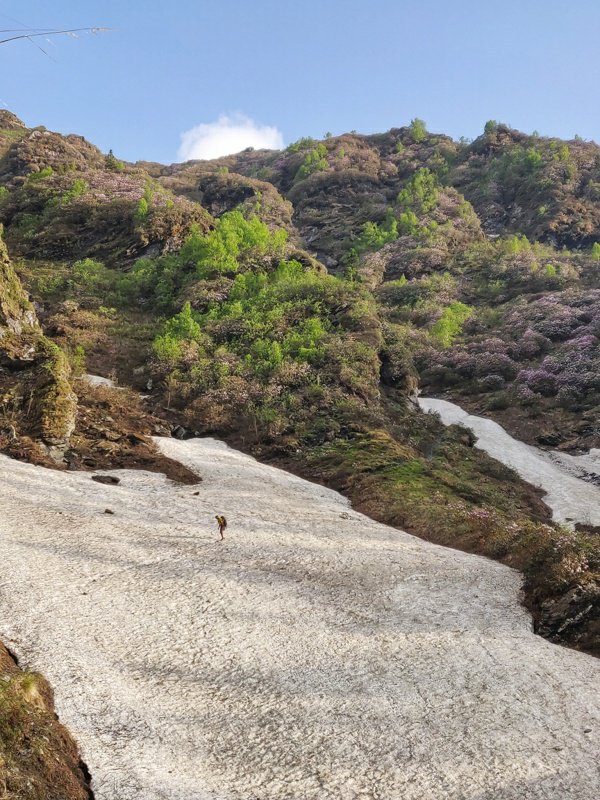 As usual snow melts slower on the Western slopes compared to those lit by the morning sun. At the time the sun is setting behind the neighbouring peaks we find a deserted rest house which is partly in ruins but still a suitable shelter. With the presence of firewood and a nearby water source we are set for the night.
As usual snow melts slower on the Western slopes compared to those lit by the morning sun. At the time the sun is setting behind the neighbouring peaks we find a deserted rest house which is partly in ruins but still a suitable shelter. With the presence of firewood and a nearby water source we are set for the night.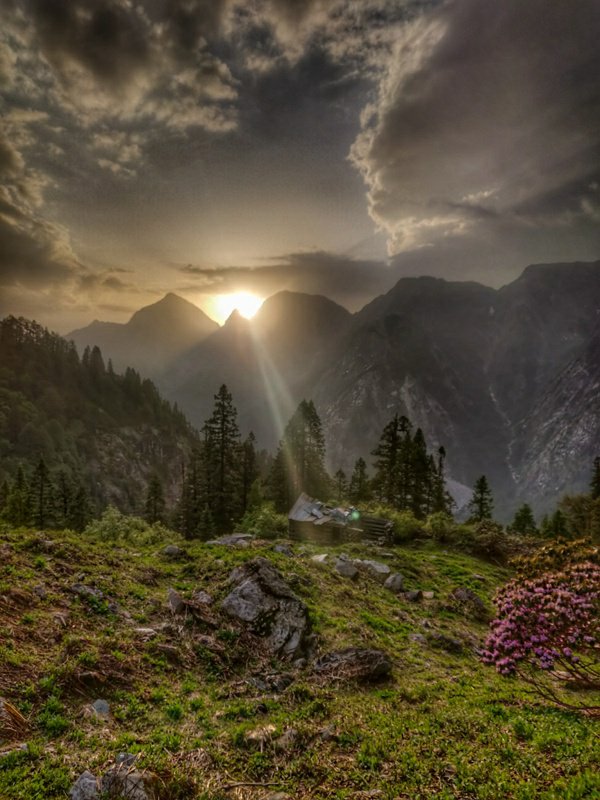 We hear some nearby noises pointing to the presence of people but are unable to locate the same. We decide to settle in the rest house which has floor covered with straw and keeps us out of the cold wind. We lit up a fire and start cooking rice and noodles for dinner.
We hear some nearby noises pointing to the presence of people but are unable to locate the same. We decide to settle in the rest house which has floor covered with straw and keeps us out of the cold wind. We lit up a fire and start cooking rice and noodles for dinner.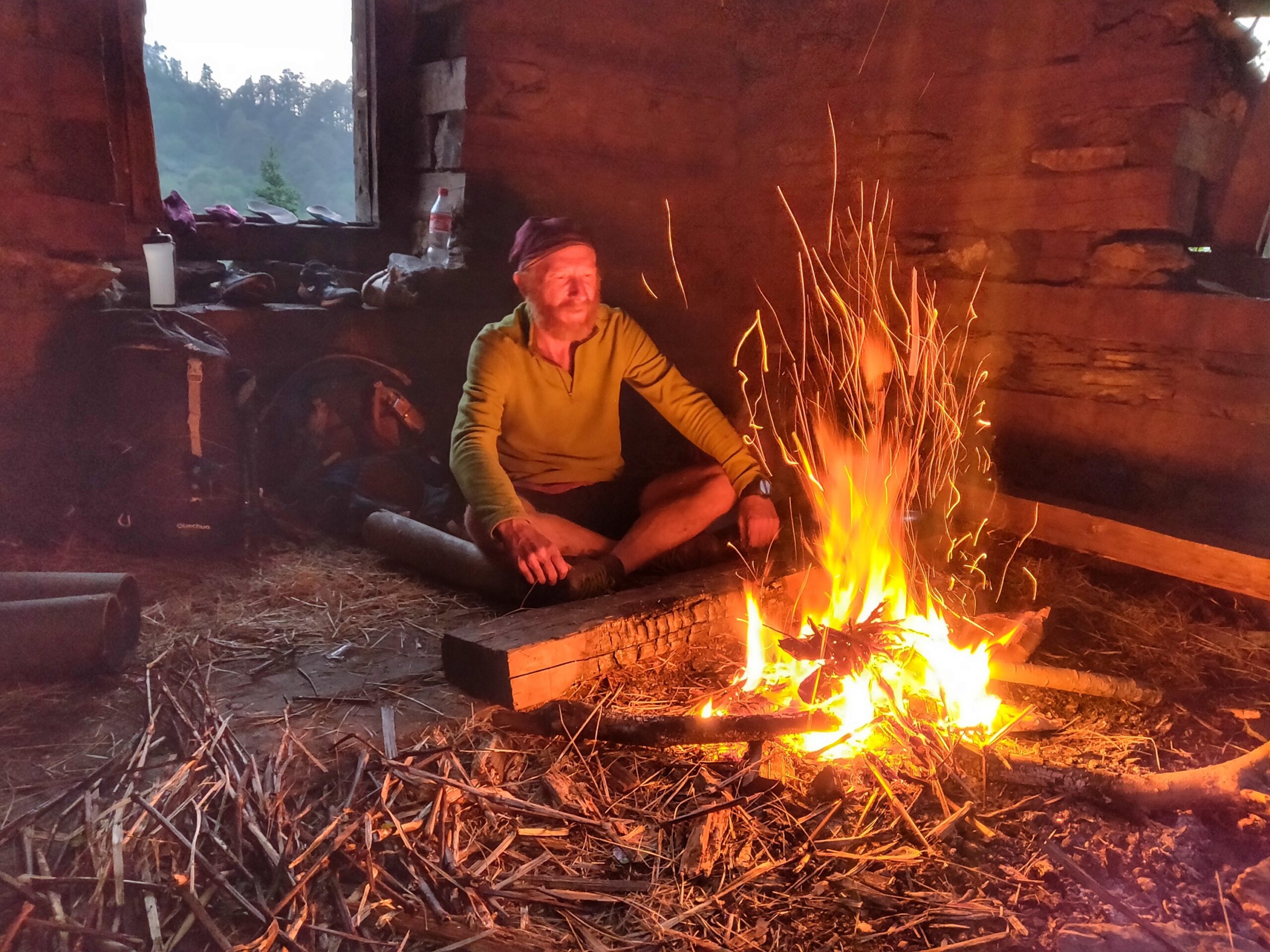 As the night falls and the temperature drops we feel warm with stomachs full and a nice campfire to keep us warm. Through the window we can see the snow covered peaks of the Parvati valley. The Pangchi Gallu pass at 4600m gateway to the Parvati valley seems impossible to cross in mid June.
As the night falls and the temperature drops we feel warm with stomachs full and a nice campfire to keep us warm. Through the window we can see the snow covered peaks of the Parvati valley. The Pangchi Gallu pass at 4600m gateway to the Parvati valley seems impossible to cross in mid June.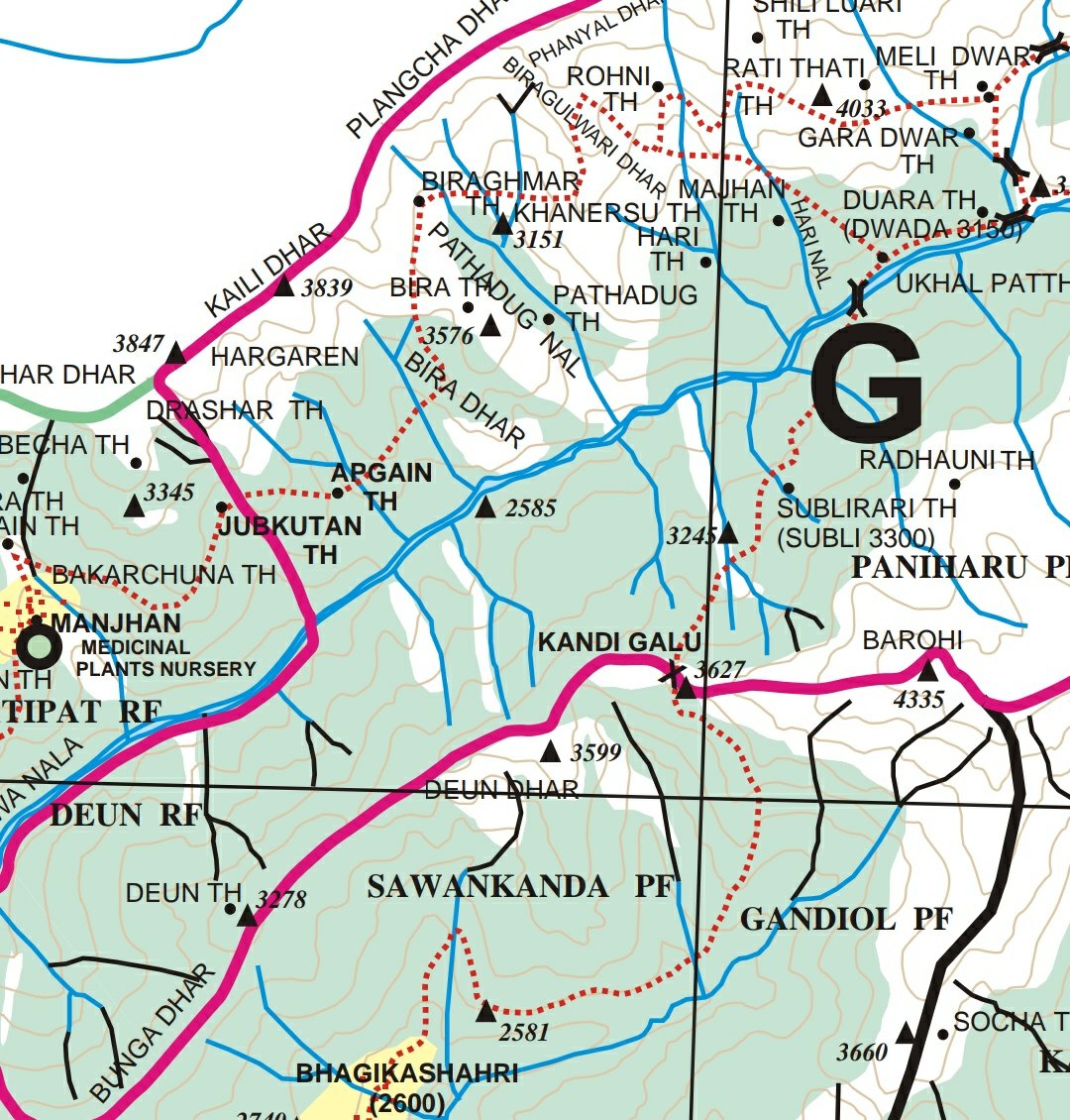 The usual OnePlus alarm tone woke us up at 6am. Getting out of that warm cosy sleeping bag is always a tough one. After the usual morning routine of piepie, poepoe, teeth brushing, packing up, stuffing few chocolates and biscuits in side pockets to munch, we were on our way.
The usual OnePlus alarm tone woke us up at 6am. Getting out of that warm cosy sleeping bag is always a tough one. After the usual morning routine of piepie, poepoe, teeth brushing, packing up, stuffing few chocolates and biscuits in side pockets to munch, we were on our way.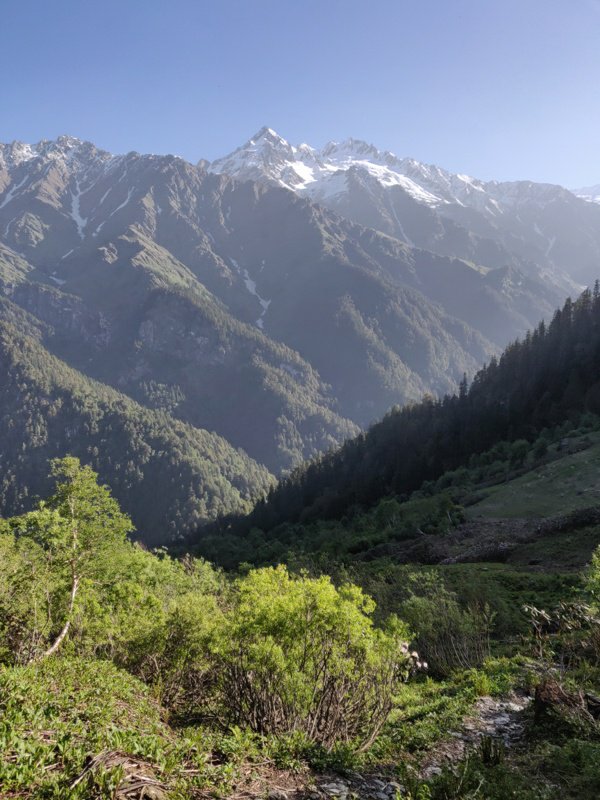 A clear path gradually descends into the Jiwa Nala valley below the snow peaks bordering the Parvati valley. We reached the stream and were searching for a bridge to cross as indicated in the GHNP map. As usual the location on the map was not accurate and we found a small bridge 3030m much earlier which got us across the turbulent Nala.
A clear path gradually descends into the Jiwa Nala valley below the snow peaks bordering the Parvati valley. We reached the stream and were searching for a bridge to cross as indicated in the GHNP map. As usual the location on the map was not accurate and we found a small bridge 3030m much earlier which got us across the turbulent Nala.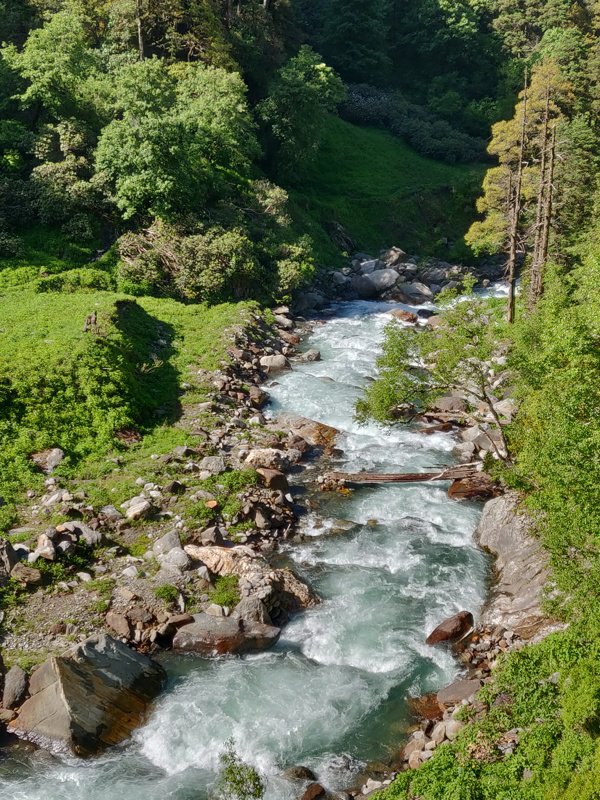 The trail towards the Pangchi Gallu pass went straight along right side of the stream. Something inside of me told me I would be back later this summer coming down from Parvati. This time we were planning to exit thrpugh the Jiwa Nala valley. We were targetting Manjan, the last hamlet in the valley.
The trail towards the Pangchi Gallu pass went straight along right side of the stream. Something inside of me told me I would be back later this summer coming down from Parvati. This time we were planning to exit thrpugh the Jiwa Nala valley. We were targetting Manjan, the last hamlet in the valley.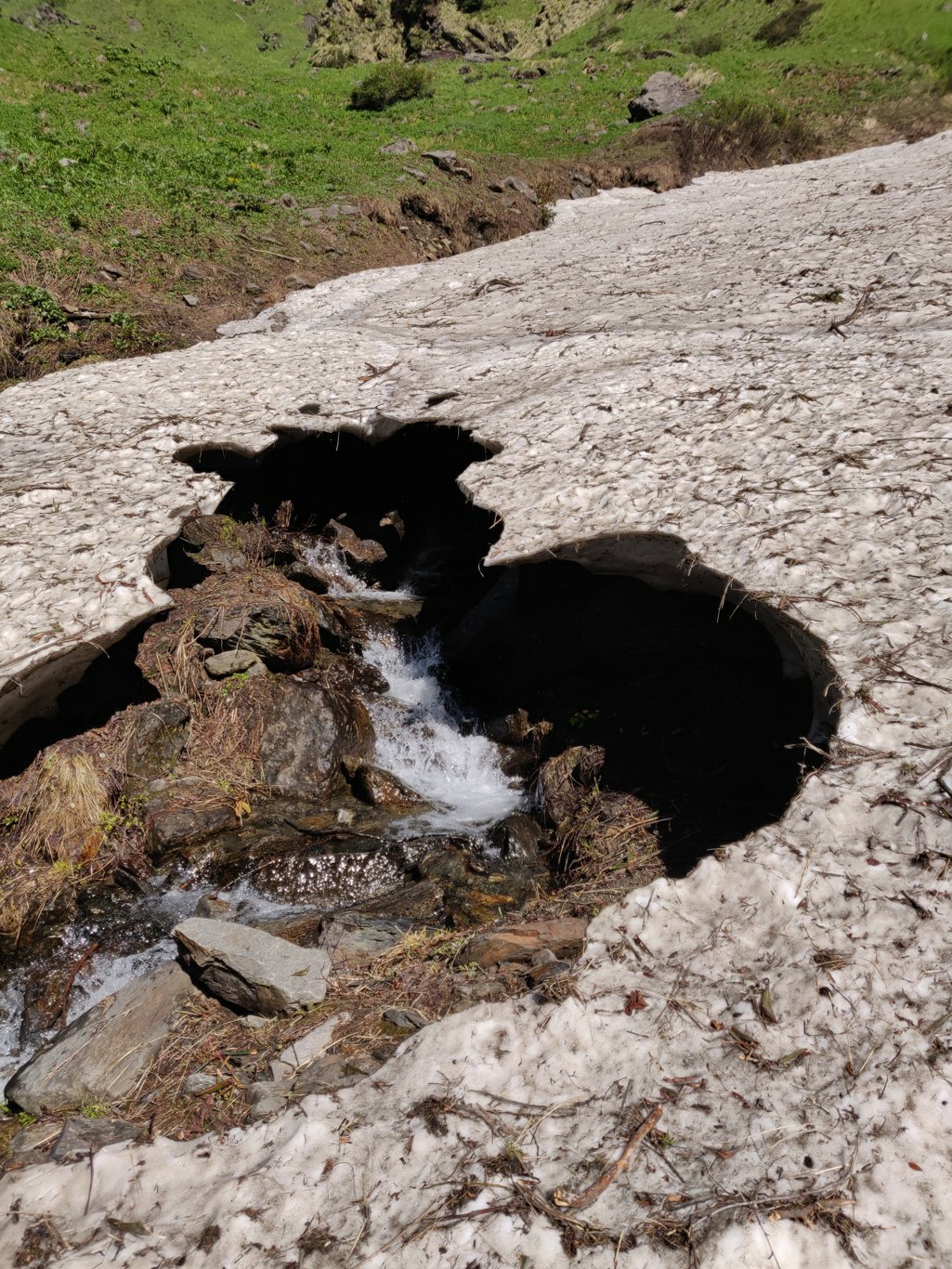 Across the bridge the trail climbs up steeply through the forest till you reach a “tach” or meadow where you cross the stream. On many side streams in the valley you can find snow sections which are yet to melt mid June even at lower altitudes. Along the way I find the remains of a “langour” which moves around jumping like a kangoroo.
Across the bridge the trail climbs up steeply through the forest till you reach a “tach” or meadow where you cross the stream. On many side streams in the valley you can find snow sections which are yet to melt mid June even at lower altitudes. Along the way I find the remains of a “langour” which moves around jumping like a kangoroo.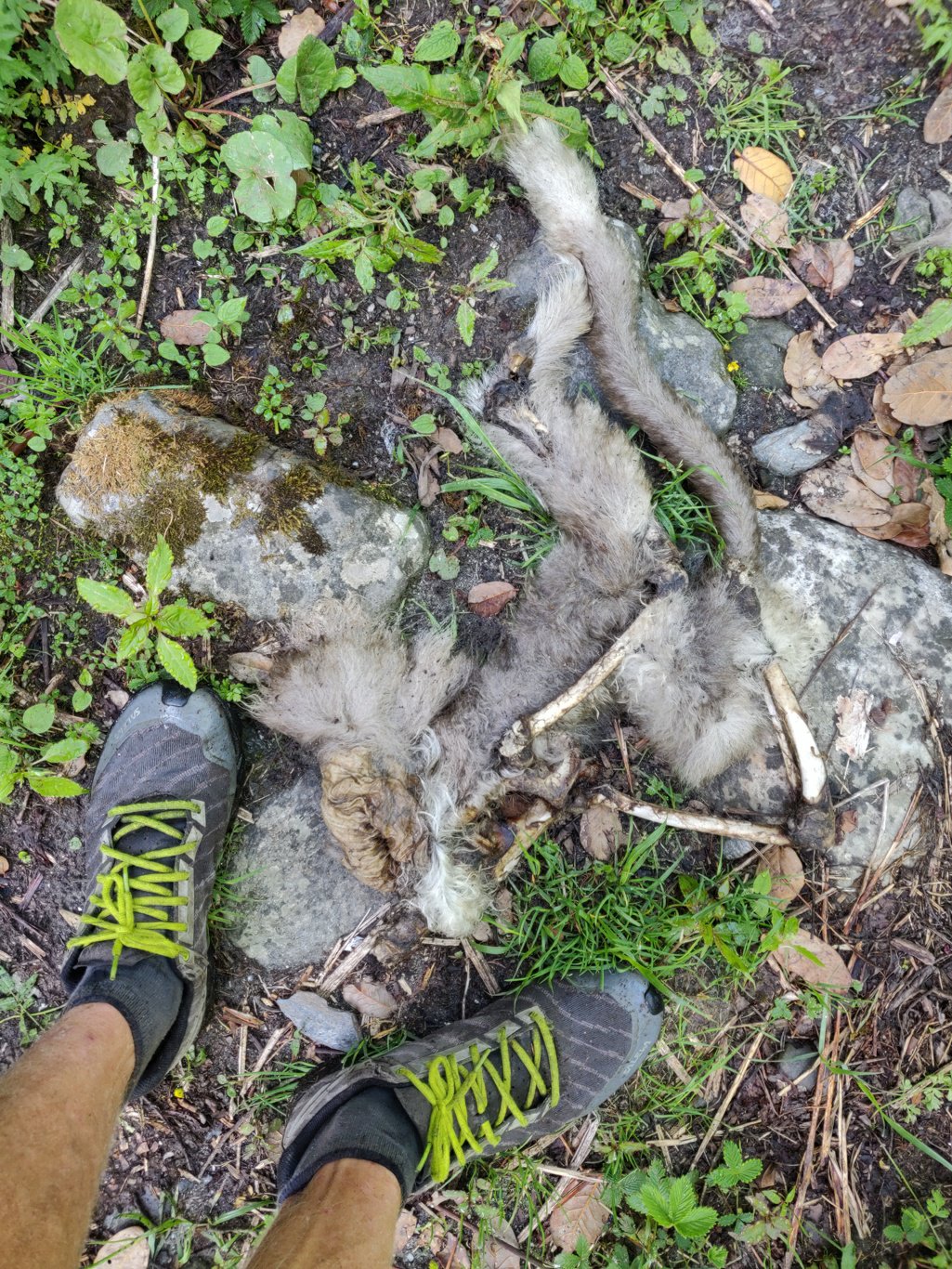 After the side stream the trail climbs up steeply 700m above Jiwa Nala through grass and rododendroms to a high point 3720m marked by a cave and small mandir, higher then the Kandi Gallu pass we entered through. From there the path contours along meadows above steep cliffs.
After the side stream the trail climbs up steeply 700m above Jiwa Nala through grass and rododendroms to a high point 3720m marked by a cave and small mandir, higher then the Kandi Gallu pass we entered through. From there the path contours along meadows above steep cliffs.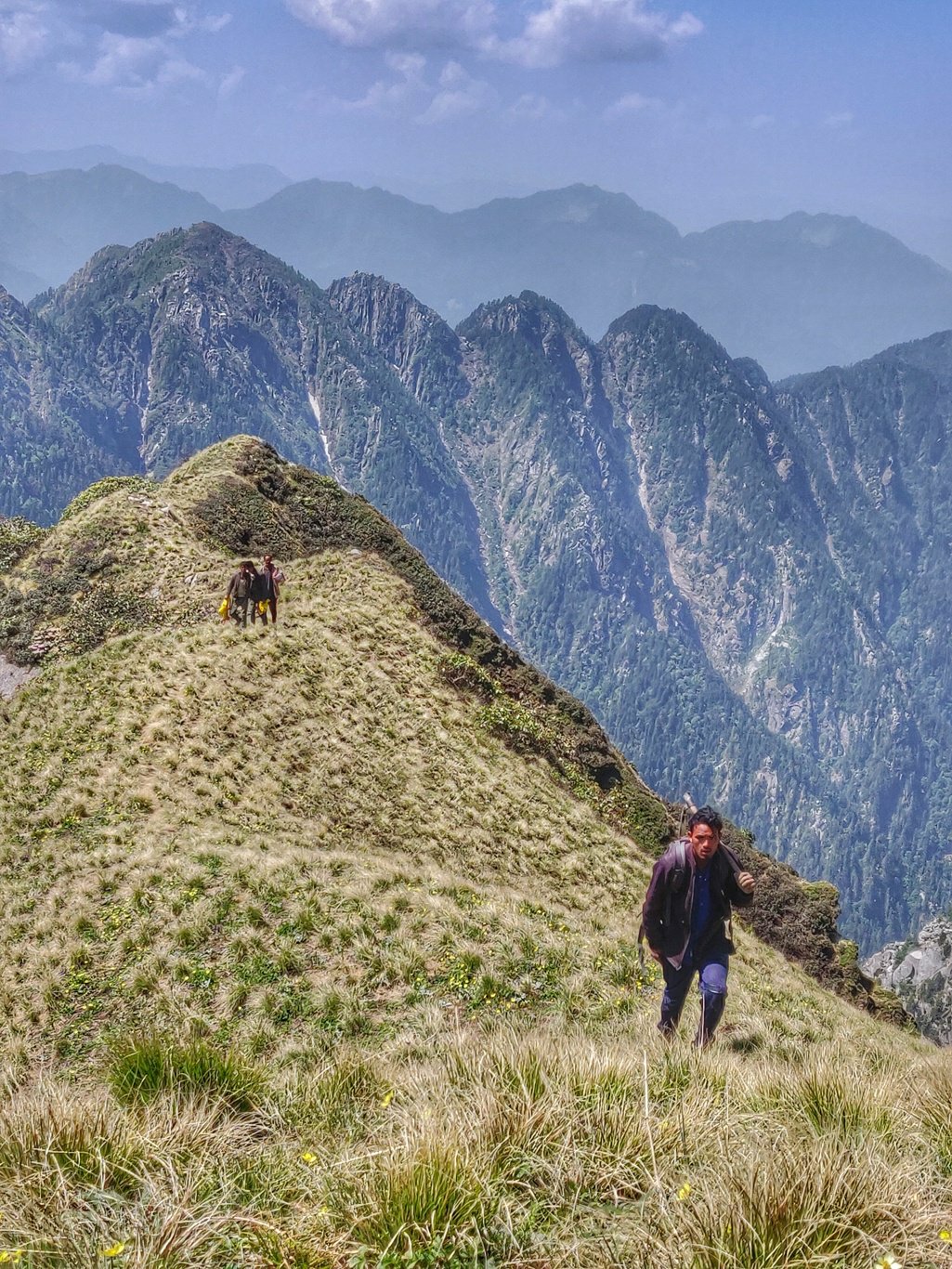 We meet 4 locals guys with digging tools collecting “jungly lassan”, a highly valued medicinal root sold for 20 thousand rupees per kg, mostly smuggled to China. The same activity happens annually in the alpine meadows of Uttarakhand and Himachal after the snow recedes. All young men leave the villages in search for the roots.
We meet 4 locals guys with digging tools collecting “jungly lassan”, a highly valued medicinal root sold for 20 thousand rupees per kg, mostly smuggled to China. The same activity happens annually in the alpine meadows of Uttarakhand and Himachal after the snow recedes. All young men leave the villages in search for the roots.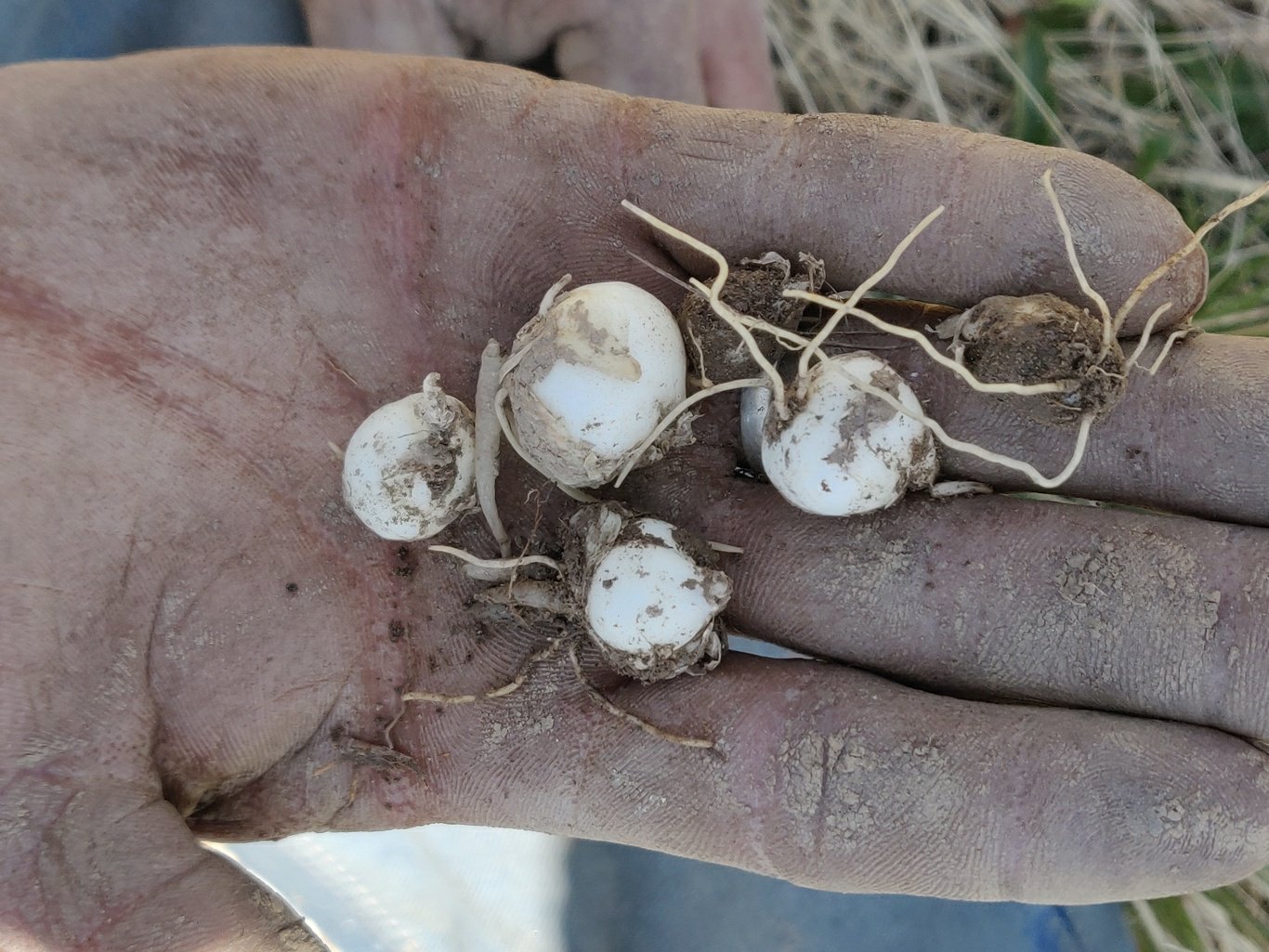 The trail keeps snaking up and down the contours (see map) as it climbs over ridges and descends into side streams while avoiding steep rockfaces. The side streams have cut deep into the valley slopes making it a tough hike across each side stream and ridge resulting in large elevation gain and lots of calories being burned.
The trail keeps snaking up and down the contours (see map) as it climbs over ridges and descends into side streams while avoiding steep rockfaces. The side streams have cut deep into the valley slopes making it a tough hike across each side stream and ridge resulting in large elevation gain and lots of calories being burned.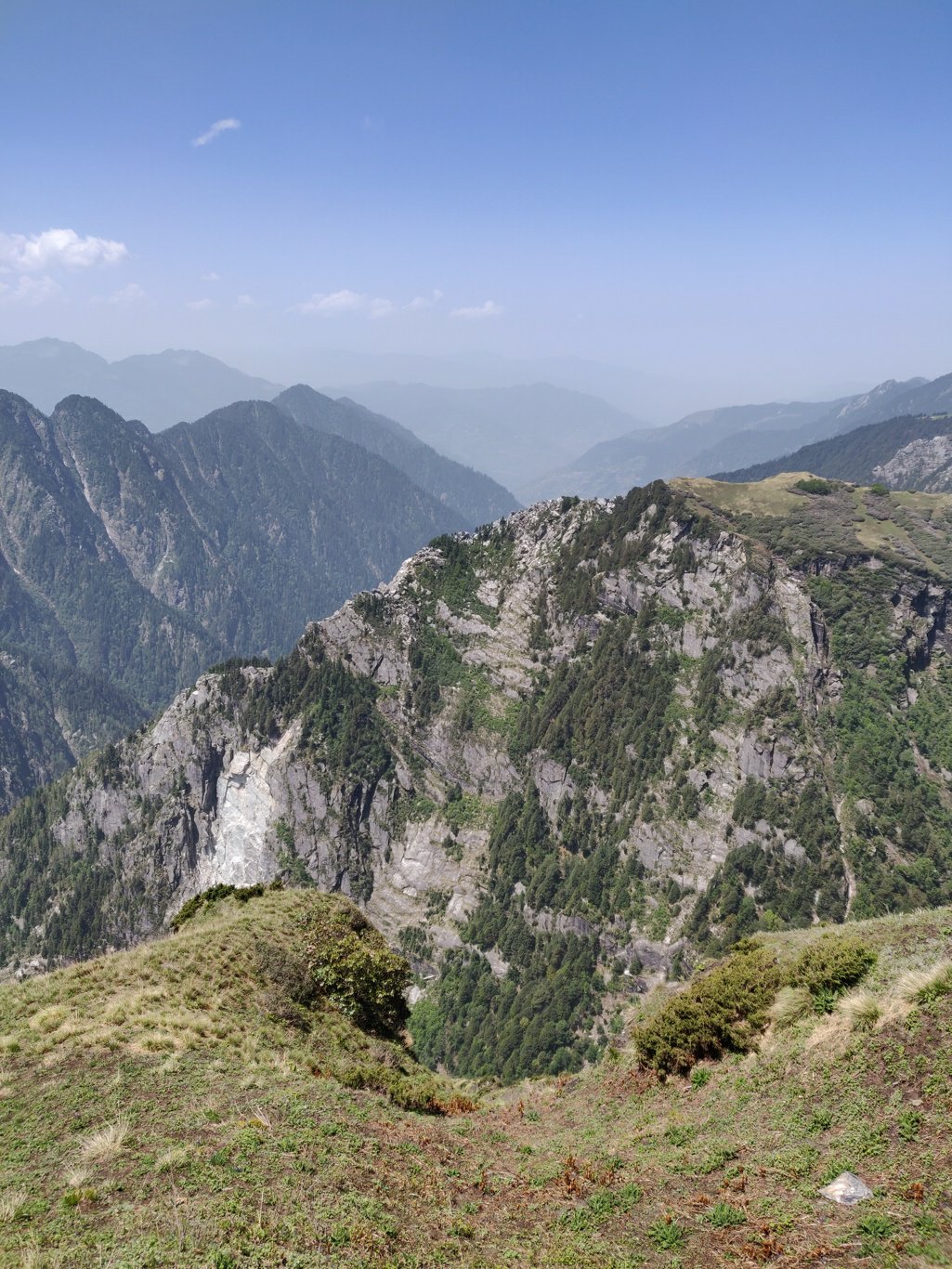 Near Khanershu the trail climbs steep down through three smaller side gullies covered with snow dropping down from a steep rockface before hitting Biraghmar Tach. It takes effort and skill to get through this more technical section of the trail. The Jiwa Nala valley definitely throws a challenge at the hiker.
Near Khanershu the trail climbs steep down through three smaller side gullies covered with snow dropping down from a steep rockface before hitting Biraghmar Tach. It takes effort and skill to get through this more technical section of the trail. The Jiwa Nala valley definitely throws a challenge at the hiker.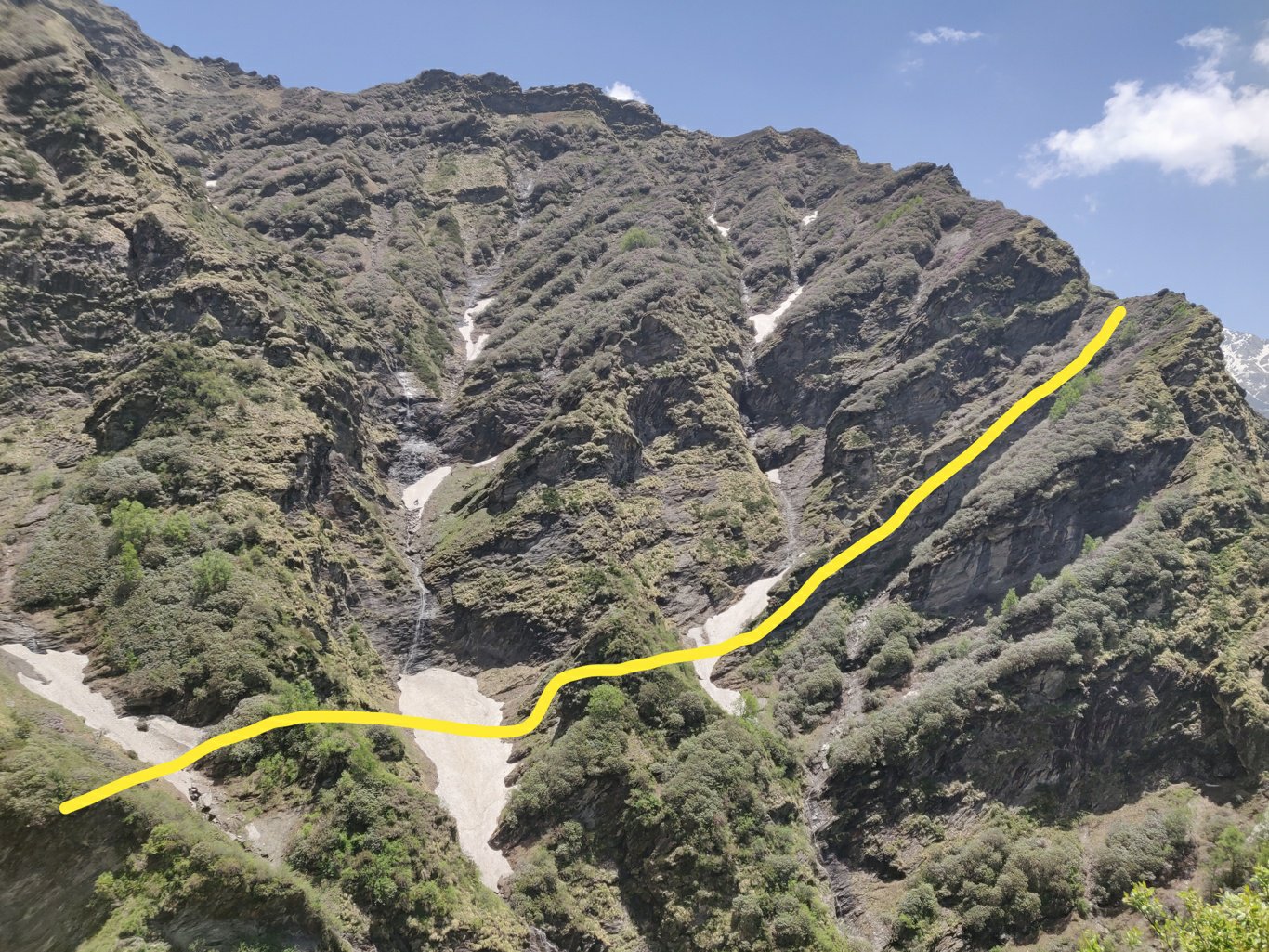
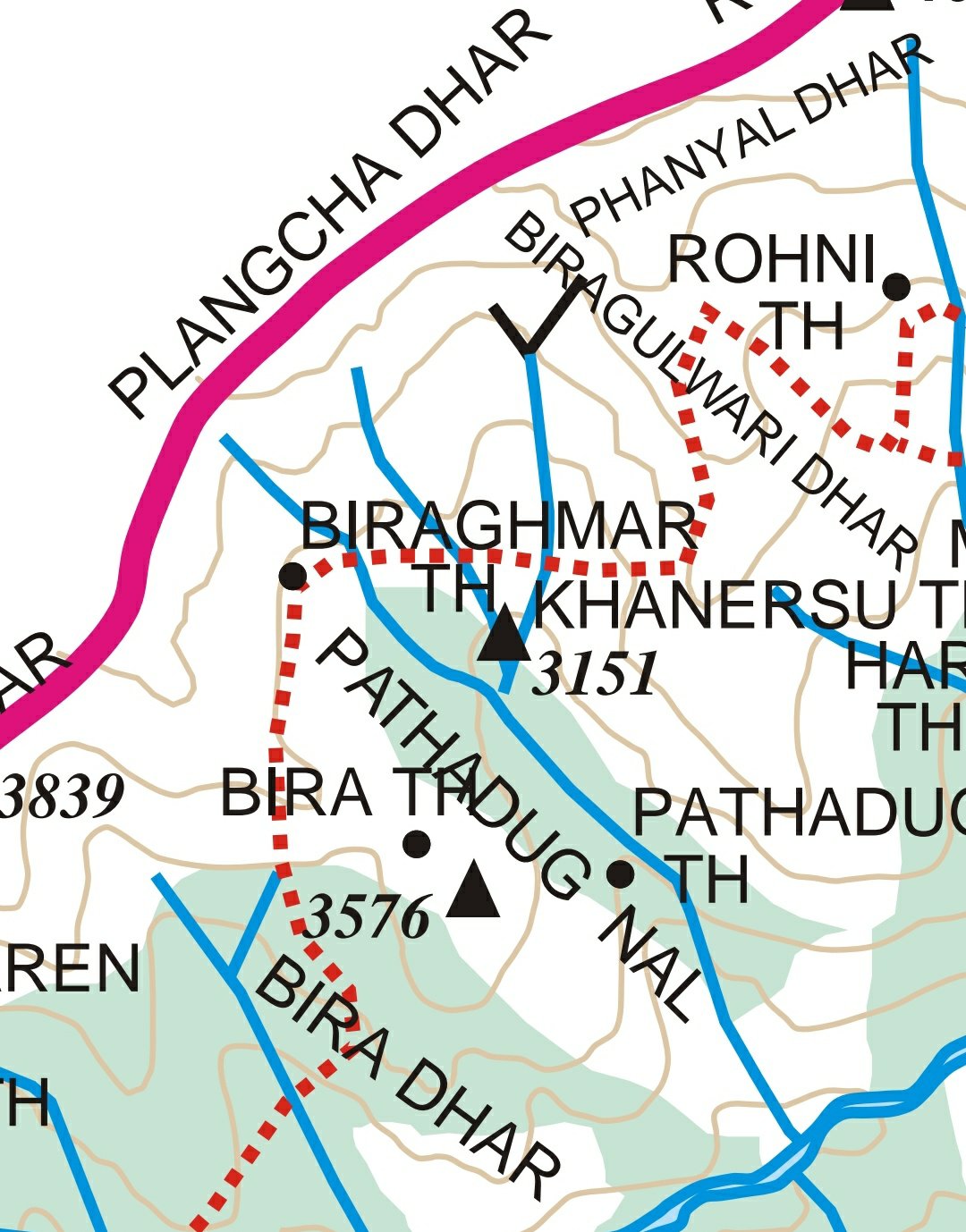 At Biraghmar we encounter the shelter of the locals where they stay overnight and keep their “fruits” of the mountains. “jungli lassan” is dried in the sun and they also collected many big crystals from the park. At 1pm after 6 hours of climbing with no breakfast in the morning the stomachs are being heard.
At Biraghmar we encounter the shelter of the locals where they stay overnight and keep their “fruits” of the mountains. “jungli lassan” is dried in the sun and they also collected many big crystals from the park. At 1pm after 6 hours of climbing with no breakfast in the morning the stomachs are being heard.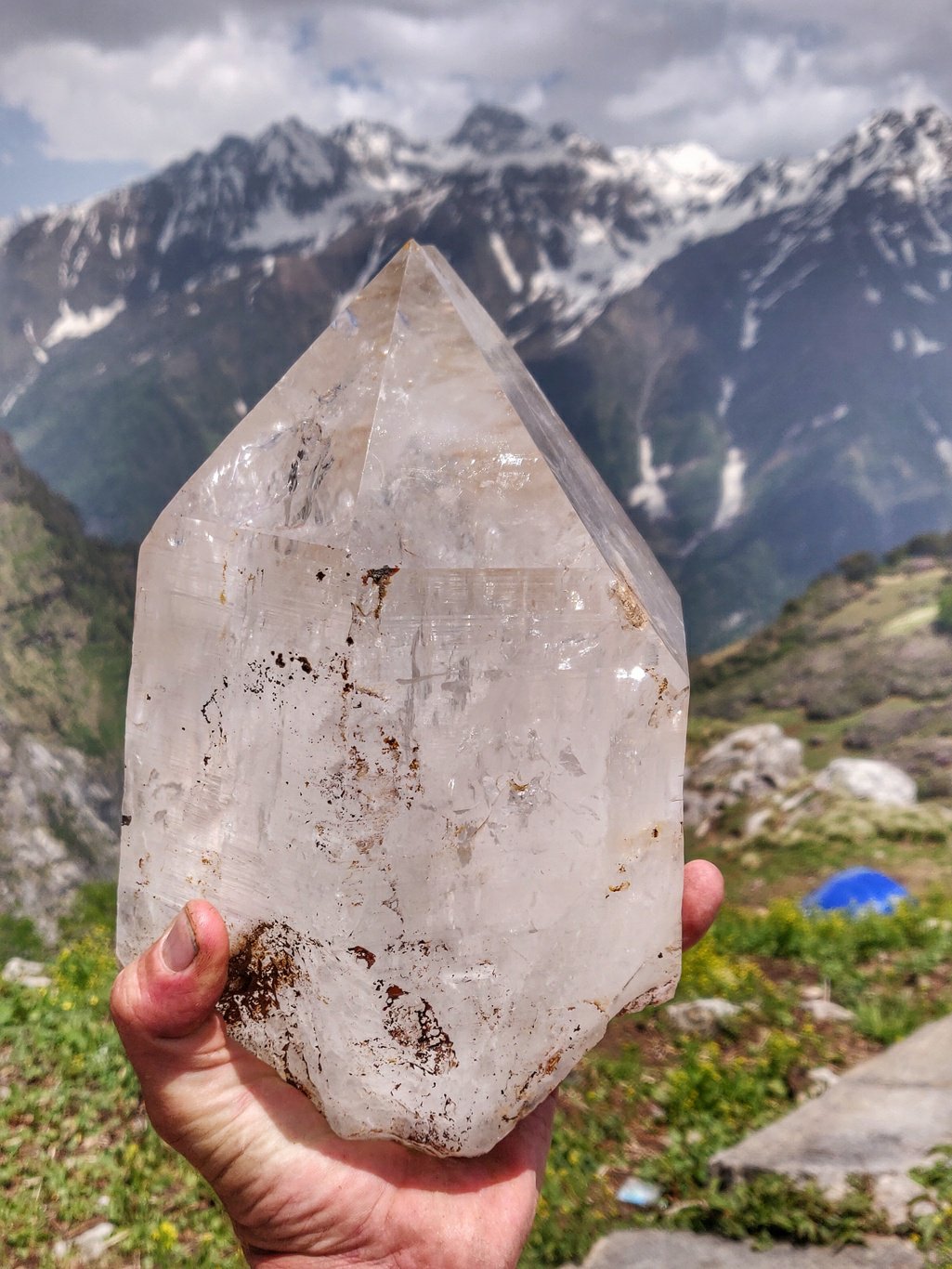 We settle down to cook Maggie noodles in the camp which offers views on beautiful surrounding snow covered peaks. From Biraghmar 3600m the trail drops down 650m steeply before crossing the next two side valleys through the forest above the Jiwa Nala. We cross another abandoned rest house in unmaintained state.
We settle down to cook Maggie noodles in the camp which offers views on beautiful surrounding snow covered peaks. From Biraghmar 3600m the trail drops down 650m steeply before crossing the next two side valleys through the forest above the Jiwa Nala. We cross another abandoned rest house in unmaintained state.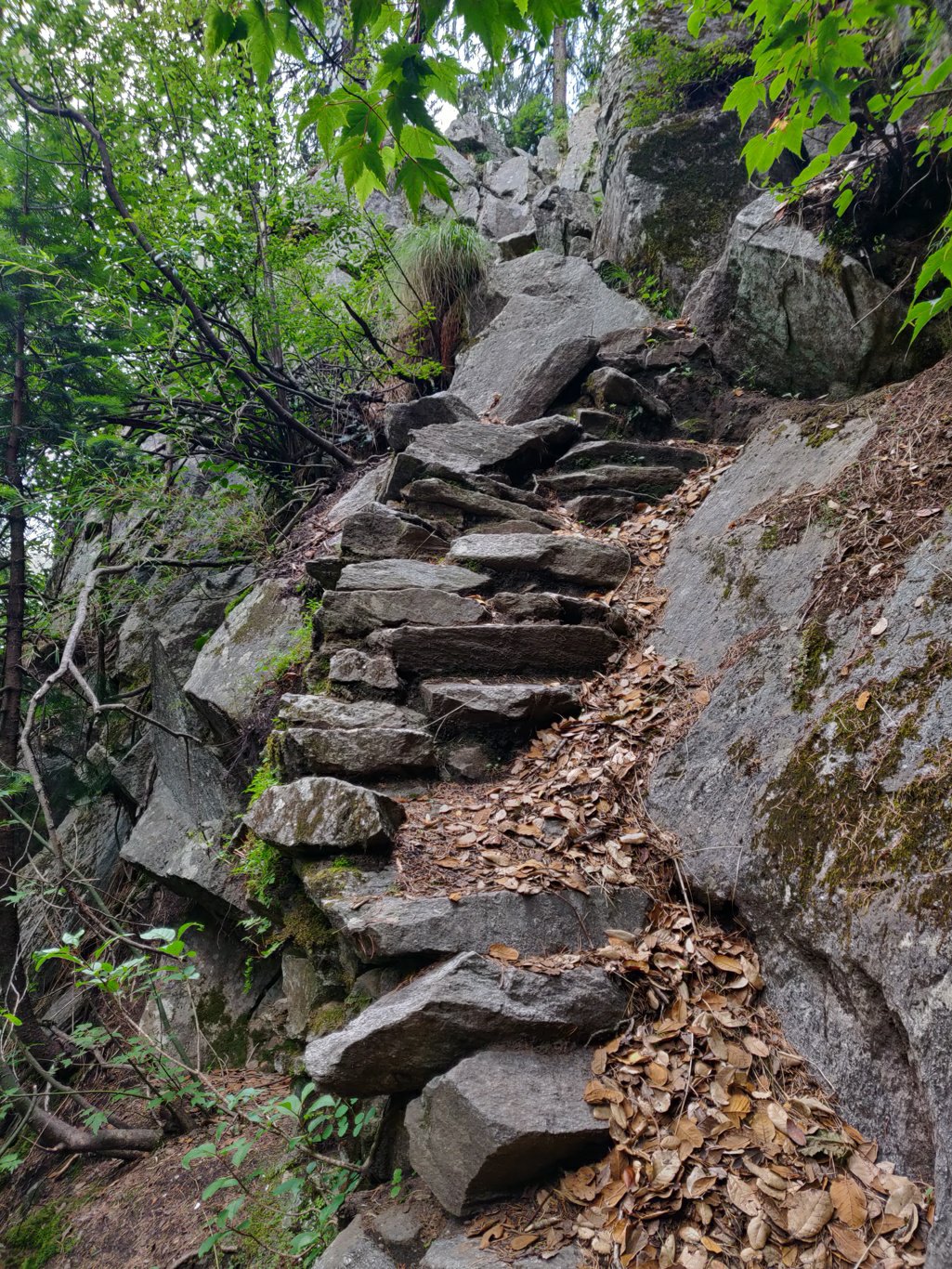 From here it’s another 1.5 hour walk to the first hamlet of Manjhan 2650m. The trail mostly contours around the ridge with few small climbs above steep rock faces at the base of the Jiwa Nala valley. The hamlet is mostly deserted. One shepherd was staying here with his herd and maybe some 2 houses were inhabited. The shepherd greeted us with two cups of hot undiluted milk.
From here it’s another 1.5 hour walk to the first hamlet of Manjhan 2650m. The trail mostly contours around the ridge with few small climbs above steep rock faces at the base of the Jiwa Nala valley. The hamlet is mostly deserted. One shepherd was staying here with his herd and maybe some 2 houses were inhabited. The shepherd greeted us with two cups of hot undiluted milk.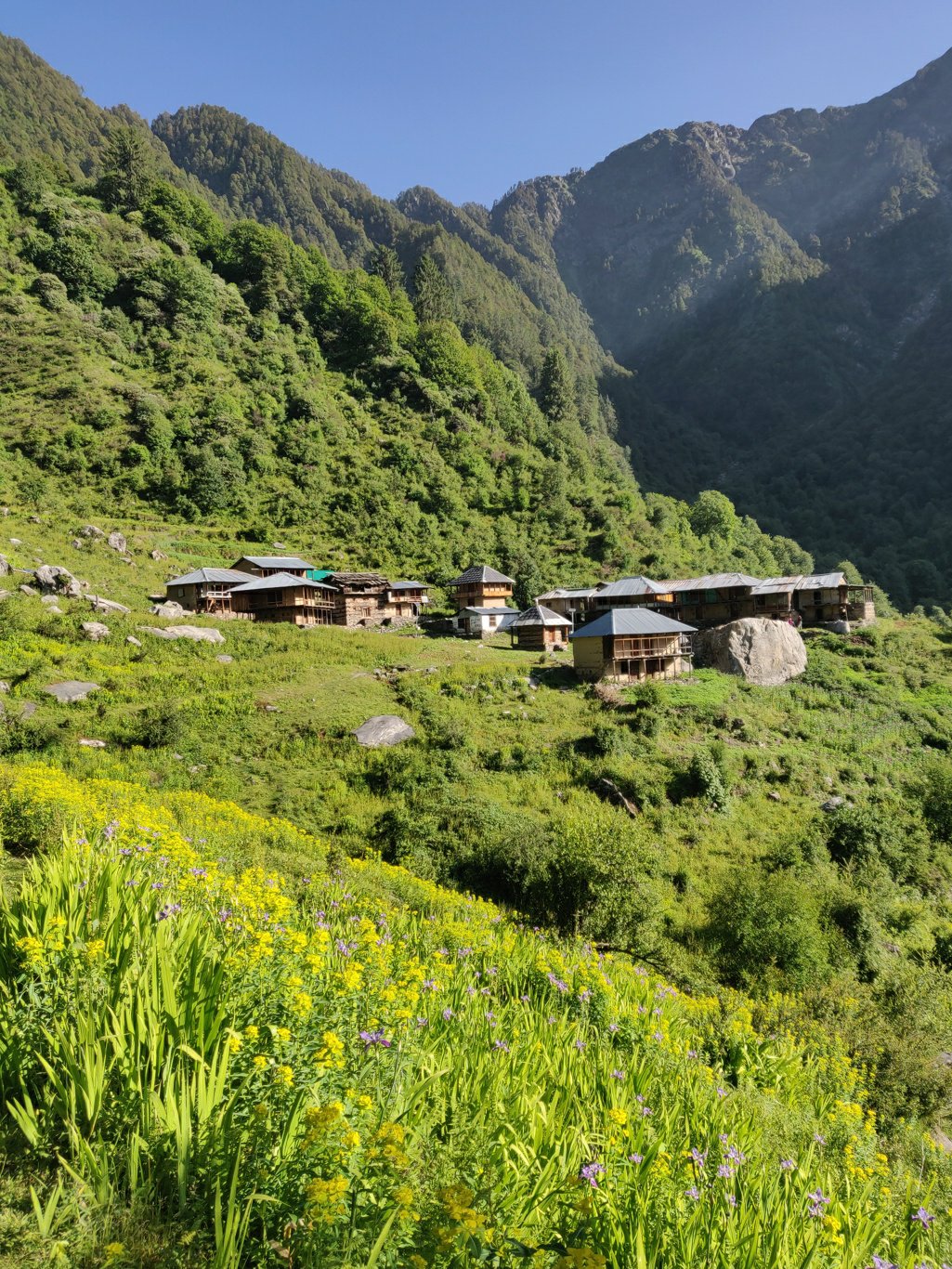 We settled down in an empty shed with wooden flooring. After sunset the temperature drops quickly at these higher altitudes. The kind shepherd gave us firewood and some of the best (heavenly is the word) dhal-ghee sabji I had tasted so far with oh-so-yummy fluffy rottis. Around the warm glow of the campfire settled down and filled out tummies after an exhausting 2 days exploration the Jiwa Nala valley.
We settled down in an empty shed with wooden flooring. After sunset the temperature drops quickly at these higher altitudes. The kind shepherd gave us firewood and some of the best (heavenly is the word) dhal-ghee sabji I had tasted so far with oh-so-yummy fluffy rottis. Around the warm glow of the campfire settled down and filled out tummies after an exhausting 2 days exploration the Jiwa Nala valley.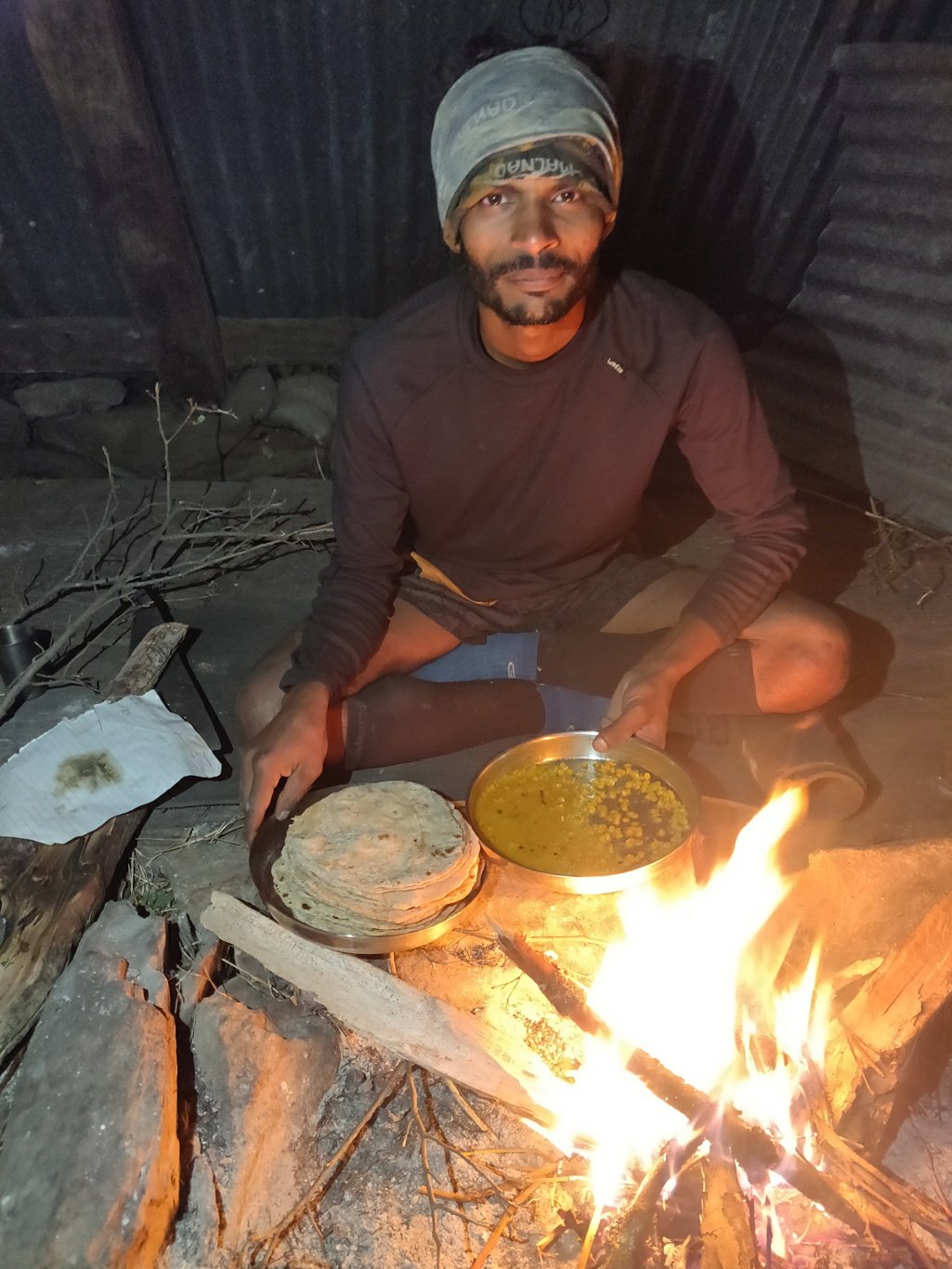 After a deep night’s rest we woke up early the next morning. The kind shepherds brought us two cups of steaming chai. We munched up the remaining rottis and sabji of yesterday, bid adieu to our host and were on our way by 5:30am. We crossed another forest rest house from where a clear path contours around the next ridge.
After a deep night’s rest we woke up early the next morning. The kind shepherds brought us two cups of steaming chai. We munched up the remaining rottis and sabji of yesterday, bid adieu to our host and were on our way by 5:30am. We crossed another forest rest house from where a clear path contours around the next ridge.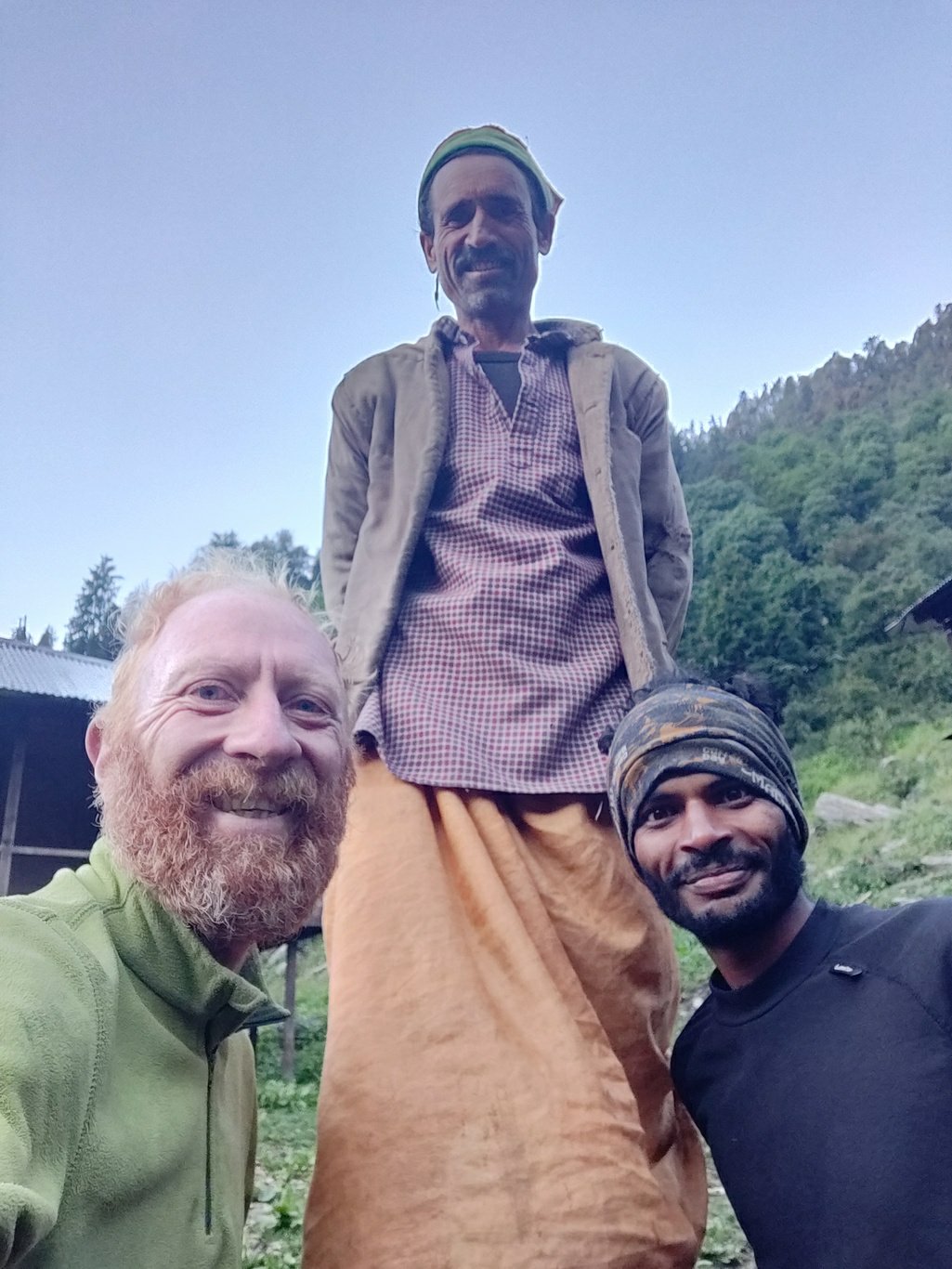 Walking through a virgin forest lit up by the early morning sun rays and singing of birds is a nearly mystical experience. GHNP is really a beautiful gem. At the ridge the clear trail seemed to vanish into thin air. We searched nearly one hour up, down and around but in vain. After navigating the entire Jiwa Nala valley we got stuck between two adjacent villages. Bummer!
Walking through a virgin forest lit up by the early morning sun rays and singing of birds is a nearly mystical experience. GHNP is really a beautiful gem. At the ridge the clear trail seemed to vanish into thin air. We searched nearly one hour up, down and around but in vain. After navigating the entire Jiwa Nala valley we got stuck between two adjacent villages. Bummer!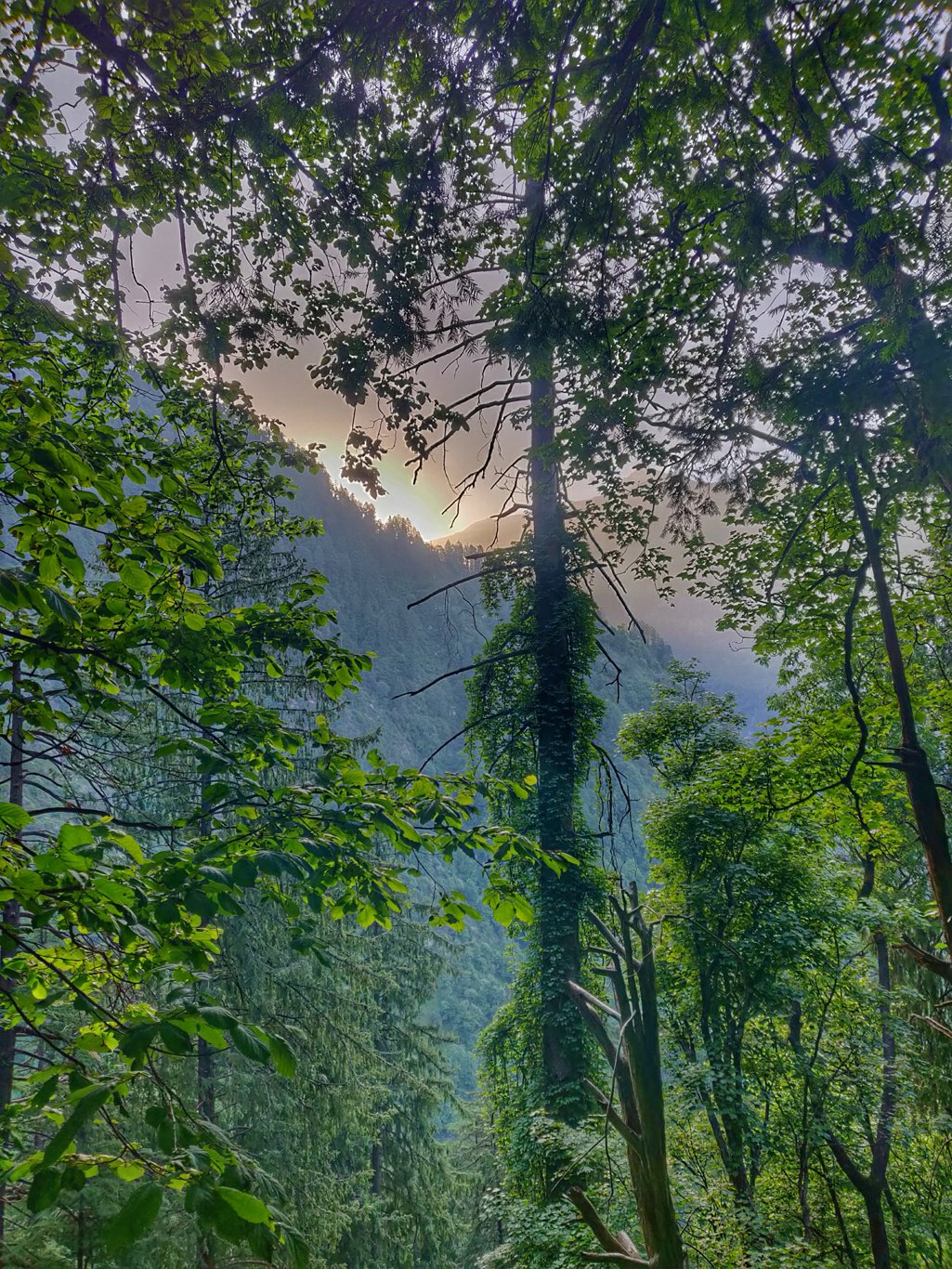 Disappointed but no other go. We had to take a U turn back to Manjhan where the shepherd told us we went in wrong way. Instead we are supposed to climb up from the forest rest house. Short on time we anyway decided to take the trail down into the valley towards and walk out through the road. We got a ride in bypassing Alto who dropped us near Sainj. Mommo time! My favourite in between dish.
Disappointed but no other go. We had to take a U turn back to Manjhan where the shepherd told us we went in wrong way. Instead we are supposed to climb up from the forest rest house. Short on time we anyway decided to take the trail down into the valley towards and walk out through the road. We got a ride in bypassing Alto who dropped us near Sainj. Mommo time! My favourite in between dish.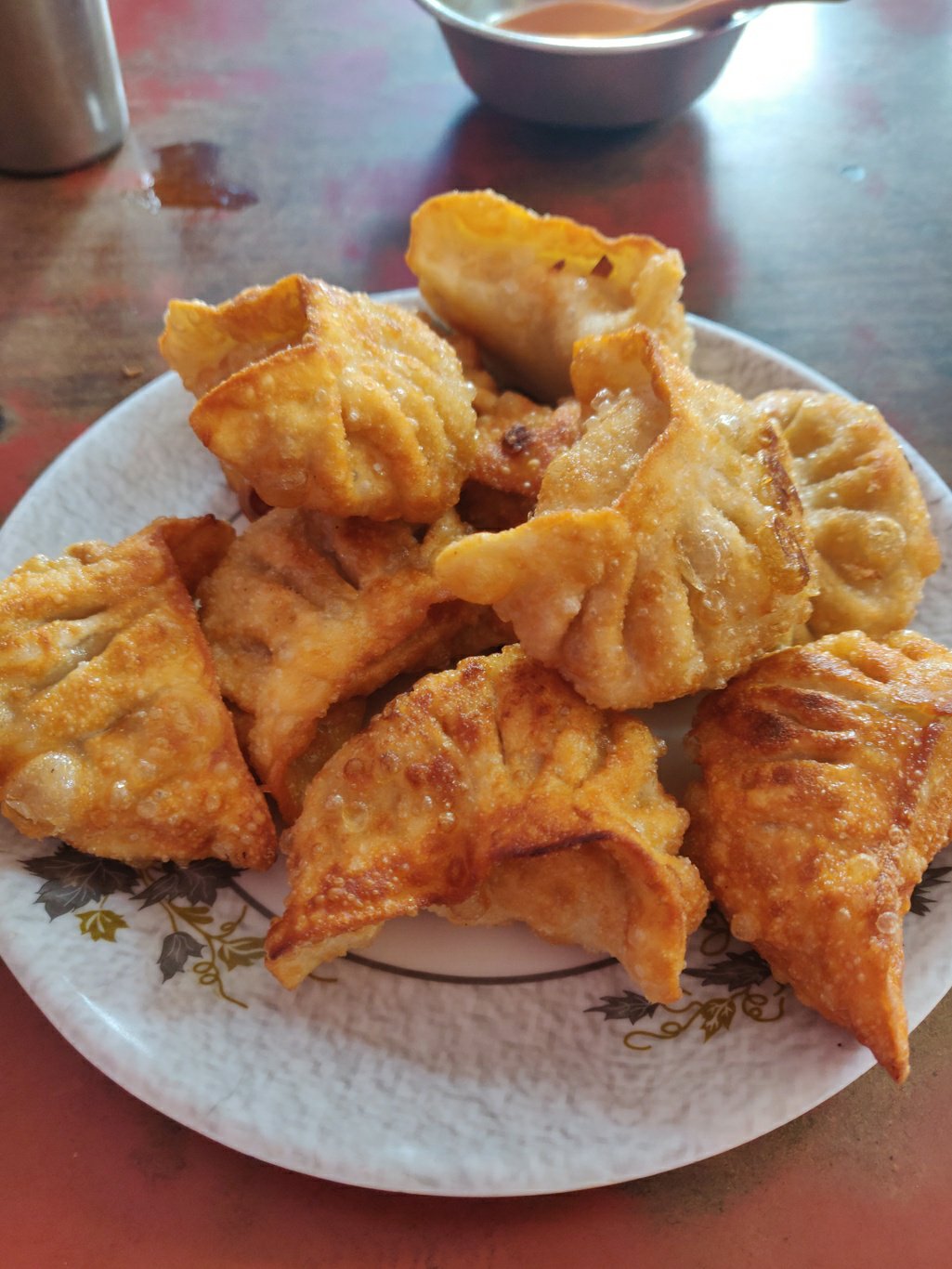 From Sainj we got into the bus to Kathi where the muddy Beas and green Sainj rivers meet. From here got in another bus to Kullu on the way to my next target: the Sari pass pathway between Lug and Barot valleys.
From Sainj we got into the bus to Kathi where the muddy Beas and green Sainj rivers meet. From here got in another bus to Kullu on the way to my next target: the Sari pass pathway between Lug and Barot valleys.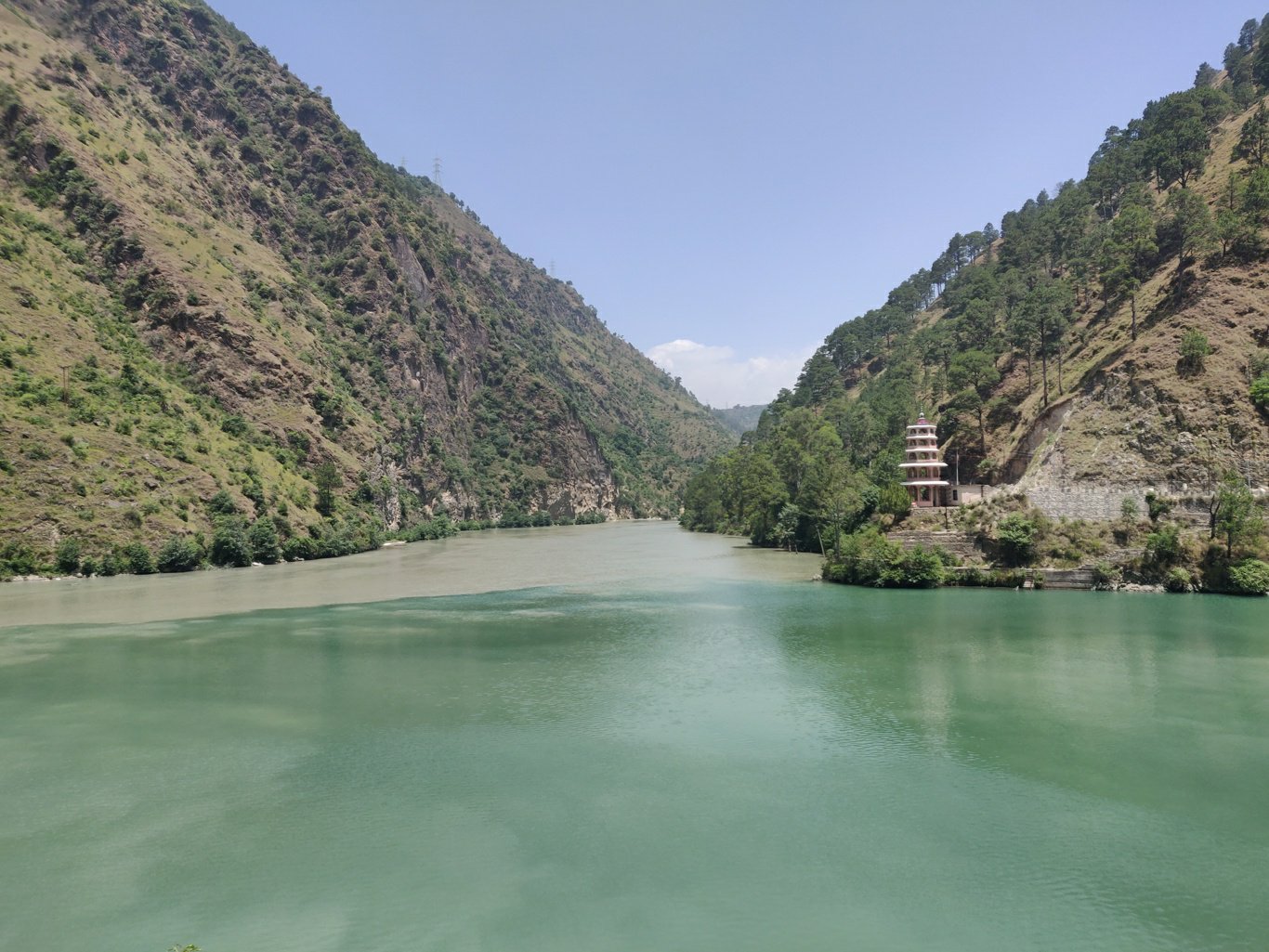
2 thoughts on “Trans Himalaya 2019 – Neuli to Siund, June 13-14”
Comments are closed.

Love the blog, makes me want to go-to the mountains even more 🙂 Thank you Peter 🙂
Beautifully written!!! Feels like you’re holding our hands and walking us thru the jungles of Himalaya. Loved it.